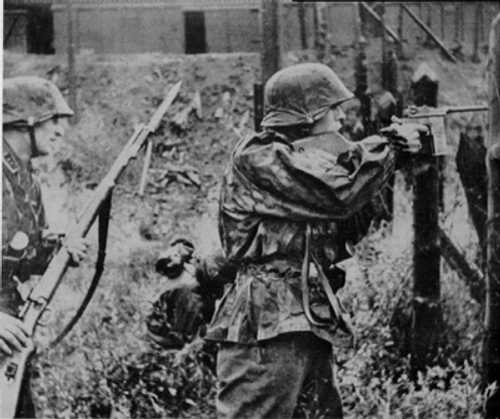
German Forces
Mauser C-96 in action.
Unknown (?Bundesarchiv)
Waffen-SS soldier (most likely officer) shooting C-96 "Broomhandle" Mauser semi-automatic pistol mounted with its detachable stock, probably Eastern Front. General production of the C-96 ceased in 1937, although limited production of one variant, issued officially to the Luftwaffe, seems to have continued for some time after. However, significant numbers of the C-96 were bought by members of the German armed forces as private purchases and subsequently used in action in WW2. The weapon had many variants, even under German production, and was widely produced under license or, more commonly, "pirated" by other countries, notably Nationalist China. The C-96 was a standard, official issue weapon to officers in WW1. It was favoured by military authorities as an alternative to the excellent, but complex and expensive to manufacture alternative, the Parabellum 08 Luger. From the users' point of view, it had the advantage of being able to deliver rapid fire at close range in an environment in which submachine guns had yet to materialize. As a high quality (if slightly weighty) semi-automatic pistol, it was still valued by many German soldiers in WW2. Strangely enough, the C-96 has an honoured place in the history of my country, Ireland. An indeterminable number were used by insurgents in the 1916 Easter Rising, and more by the Irish Republican Army in the subsequent Irish War of Independence. A little-known highlight of its "career" took place in the Easter Rising in 1916. Éamonn de Valera, Commandant of the Boland's Mills garrison, lent his C-96 to Lieutenant Michael (Mick) Malone, with orders to occupy the junction around Mount Street Bridge. This bridge spanned the Grand Canal over a major (and obvious) route into central Dublin from an (obvious) point of landing of British reinforcements at Kingstown (now Dún Laoghaire). Malone deployed his 17 Volunteers with (for this rebellion) unusual skill around the bridge, himself taking up position along with three or four riflemen in Clanwilliam House, which covered the bridge itself. The expectation that the British would advance along this route proved correct. Two battalions of the Sherwood Foresters, on arriving by ship at Kingstown, were ordered to relieve the besieged Dublin Castle, advancing along the obvious route. These soldiers (and officers) were half-trained, and were supposed to be going to France. They crossed Mount Street Bridge in ignorance of the presence of Irish Volunteers in the area. Only when they were across did Malone order his troops to open fire into the British column. The result was carnage, in no small part due to the rapid fire from Malone's C-96. The hapless British officers - to whom "urban warfare" would not even been a recognized concept -then drew their swords (I kid you not) and organized a charge on the door of Clanwilliam House. Big mistake - those Georgian/Edwardian houses have big, heavy doors, and this one was barricaded from behind. The only result was to bring a confused mass of Foresters directly under the rifles of the Volunteers, and Malone's C-96. Further mass casualties were inflicted on the British, who were forced to retreat over the bridge, where they were pinned down, many lying prone on the ground where they were still exposed to Volunteer fire from Clanwilliam House and other Volunteer positions, a situation producing many more British casualties. The obvious course, in retrospect, was for the British to outflank the Mount Street Bridge position, leaving a small force to keep it busy. This would have been easy; neighboring Baggot Street Bridge was only about half a mile away, and was, as far as I can determine, unguarded. However, with typical WW1 "pluck" - and stupidity - the British continued to attack across Mount Street Bridge, suffering heavy casualties. Many of these casualties were inflicted by Malone's C-96, which was as close as the rebels had to a machine-gun. This went on for two days. It was finally settled by a British attack, supported by machine guns and led by soldiers with grenades. The grenades ignited the gas supply of Clanwillian House, which promptly burned the house down. Most of the Volunteer defenders escaped over the rooftops. Mick Malone did not - he had already been shot to death in the latter stages of the battle. How might this incident have turned out if the Irish Volunteer contingent had a machine gun ? Or if Malone had not borrowed Dev's C-96 ? We cannot know; these are unhistorical questions. What actually happened is an example of what a difference a single weapon can make in appropriate circumstances ... Yours from the GPO, JR.
4081 Views
4/9/2006
